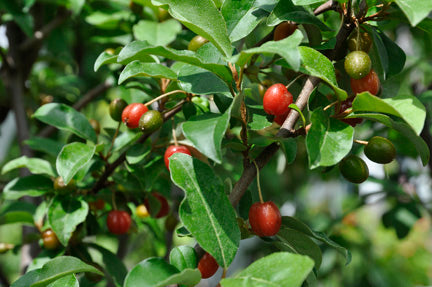
Elaeagnus multiflora
Red Gem Goumi is native to the Russian Far East, China and Japan. Goumi forms a medium size shrub growing to 6 ft in height with attractive, silvery green foliage. The white flowers bloom in the middle to the end of May and are very fragrant and loved by bees making it a fantastic pollinator. The juicy, scarlet-red fruit is speckled with silver and ripens in July. Aromatic with a flavor reminiscent of pie cherries, it is very good eaten fresh and also makes tasty preserves. An added advantage of Goumi shrubs is that they do well in poor soils. Goumi fruits have very high nutritional value, they are high in vitamins C, A and E, antioxidants, essential fatty acids and flavonoids.Full to half day sun. Self fertile. Zone 4-8
| Plant Characteristics | |
|---|---|
| Pest Resistance | Excellent |
| Disease Resistance | Excellent |
| Drought Tolerance | Good |
| Heat Tolerance | Very Good |
| Humidity Tolerance | Very Good |
| Sun Tolerance | Excellent |
| Wet Soil Tolerance | Poor |
| Shade Tolerance | Fair |
| No Spray | Excellent |
| Salt Tolerance | Poor |
| Fresh for Kids | Very Good |
| Plant Type | Shrub |
| Soil Type | Adaptable |
| Edible Type | Fruit |
| This information is accurate to the best of our knowledge, comments/opinions are always welcome | |
Care Guide
From our experience, Goumi belonging to the Eleagnus family are easy to grow and long lived, disease free and attractive.
Goumi are not large shrubs. When fruiting, harvesting is easy from the ground. The ripe fruits can be picked and left at room temperature to mellow. Fruits are usually tastier a day or so off the bush. Fruits contrast with their red color against the green leaves of the bush. Also, the bark of the bush is cinnamon colored. These colors together are ornamental.
Convenient placing of the shrub near the house brings it to mind more often for easy harvest or shaping. Shady spots will produce a lanky specimen, while full sun gives a plant with a compact look.
Once planted, the first season, keep watered so the roots grow into its new home. In our pots, the vigorous roots grow quickly and may need teasing to pull away from the shape of the pot. It's important to have the plant planted with new soil surrounding the roots. Lots of new growth should be noticed during the growing season. Goumi are not invasive and will not spread from your original planting.
Since this fruit is generally unknown to the American public there are not a lot of creative recipes out there. First, it's good fresh. It works with other fruits, especially ones that ripen at the same time such as strawberries, haskaps (Edible Honeysuckle), mulberries and blueberries.
The nutritious fruits can also be used in blender drinks or seasonal green salads. A young lettuce salad with a vinaigrette dressing (made with or without the Goumi included) is an eye appealing treat. Mixed greens, some Goumi, raisins, walnuts and dressing is a delicious choice for spring dinners. Banana based smoothies will turn a bright pink with the addition of Goumi fruits. A Goumi torte would be extremely good. Find a torte recipe and substitute the said berries for Goumi.
Be sure to show your neighbors this bush especially when it's in fruit. It can also be grown in public sites such as parks, schools, and business.
We have not had birds or squirrels taking the harvest, but different situations could bring animals to the harvest. Plants can be netted or protected easily because of their size.
Goumi can have short stems that end in a point, so handle your new plant carefully.
Thank you for purchasing a great plant for your Edible Landscape!


